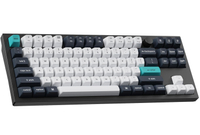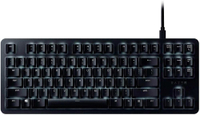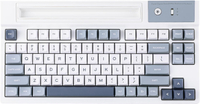The best mechanical keyboards in 2024
The best mechanical keyboards you can buy, based on our testing and reviews
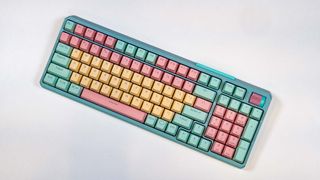
The best mechanical keyboards will elevate your typing experience. With the right keyboard switches, you can type faster, more accurately and more comfortably than a standard membrane keyboard. Some options can be pricey, but if you do a lot of typing, the investment will pay off every time you sit at your desk. It doesn't matter whether it's your latest email, a new short story, or a congratulatory "GG" after your latest Helldivers 2 session.
Buying a mechanical keyboard can also open the door to a whole community of keyboard enthusiasts. If you care to step through that door, you can easily spend hours researching the best switches, keycaps and layouts for your ideal mechanical keyboard. This is why you want a mechanical keyboard: They're generally more customizable and more durable than your average membrane keyboard.
Whether you need a bright, loud gaming keyboard or a subtle, satisfying mechanical keyboard to type on all day without waking the neighbors, you'll find it in the following list, including some of the best gaming keyboards on the market.
The quick list
Here's a quick overview of the best gaming keyboards you can buy right now based on our testing and reviews.
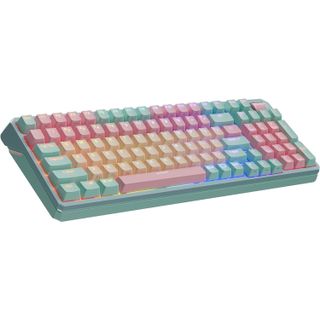
The Cooler Master MK770 is a fantastic keyboard for both typists and gamers. The responsive Kailh Box V2 switches and sturdy gasket-mounted design create a comfortable typing experience. The Macaron color option is also quite nice, as is the hot-swappable design.
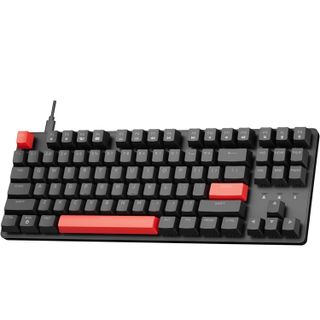
For $36, the Lemokey X1 offers awesome typing and gaming performance. It’s built like a premium keyboard and has customizable backlighting via user-friendly software. However, the premium construction doesn’t extend to the X1’s keycaps, and isn’t hot-swappable.
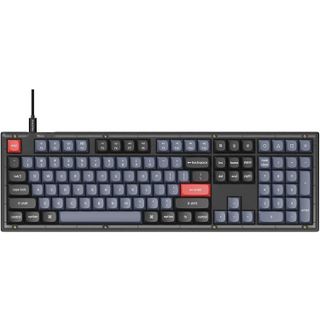
The Keychron V6 features an attractive design, smooth typing, lovely sound and fantastic build quality. It’s fully hot-swappable and available in a variety of guises to suit your needs. Unless you want wireless connectivity, there’s very little reason not to buy one.
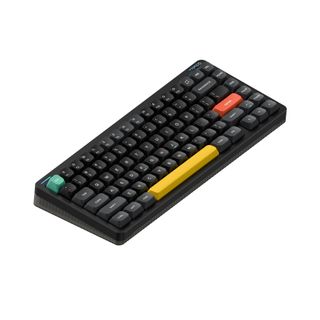
The NuPhy Halo75 V2 is gorgeous to look at, listen to and type on. It polls at 1,000Hz in 2.4G mode, so it'll be fast enough for gaming, too. We have our gripes about it, but all are pretty minor. This is doubtless a worthy successor to the original Halo75.
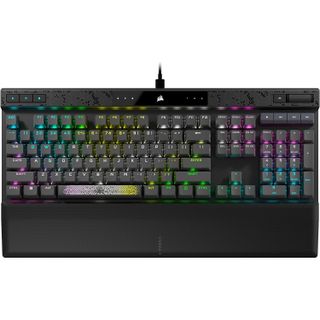
The Corsair K70 Max bears the familiar Corsair keyboard design but its magnetic switches and high level of customization arguably make this the company’s best board yet. If you can ignore its high price, this is the keyboard to get if you’re looking to elevate your PC gaming experience.
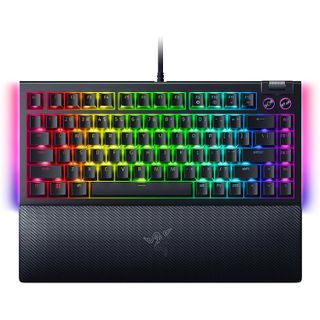
The Razer BlackWidow V4 75% isn't cheap but we argue it's worth every dollar thanks to its compact size, responsive tactile keys, hot-swappable design and comfortable typing experience. And like most Razer products, you can reprogram the BlackWidow V4 through the Razer Synapse app.
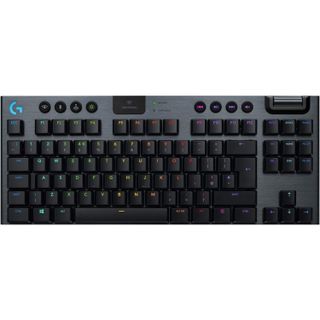
With its low-profile keycaps, comfortable switches, gorgeous RGB lighting, reliable wireless connectivity and discrete media keys, there's a lot to like about the Logitech G915 TKL’s design and performance. However, it does cost a lot for a smaller keyboard. But if that's not an issue, this is a keeper.
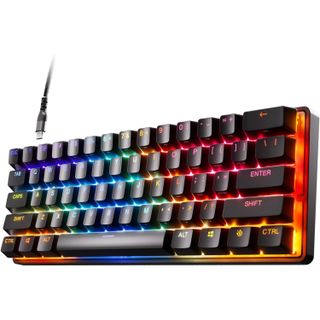
The SteelSeries Apex Pro Mini offers a high-quality build and a versatile range of per-key customization options. Though designed for competitive gamers, it's also an excellent 60% keyboard for typists who want a compact board. However, it comes with a comparatively steep price.
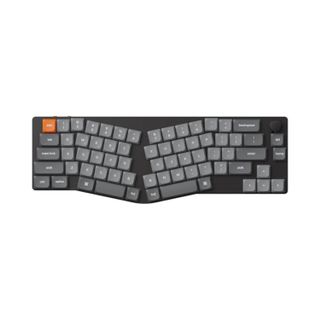
The Keychron K11 Max is a wireless ergonomic keyboard that offers a comfortable typing experience thanks to its Alice layout, plus it’s hot-swappable with a premium construction which makes it a winner. That said, its finicky companion software and loose feet might turn you off.
The best mechanical keyboards you can buy right now
Why you can trust Tom's Guide
The best mechanical keyboard overall
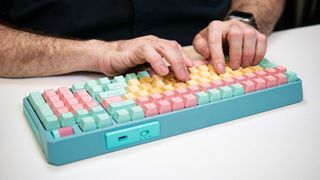
Specifications
Reasons to buy
Reasons to avoid
The Cooler Master MK770 is an all-around excellent keyboard for typists and gamers alike. The gasket-mounted design and KailhKailh Box V2 switches pair wonderfully to create a truly comfortable and pleasant peripheral, especially if you opt for clicky white switches. The Macaron color option also gives this otherwise standard board a stylish flair. And if you want to change the switches or mod the board, the hot-swappable design facilitates that.
Despite issues with the MasterPlus software, the Cooler Master MK770 is a fantastic keyboard, especially at the relatively affordable $119 asking price. That’s more than a typical membrane keyboard, but over $100 less than something like the equally excellent Meletrix Boog75. For what it offers, the Cooler Master MK770 comes with my highest recommendation.
Read our full Cooler Master MK770 review.
The best budget mechanical keyboard
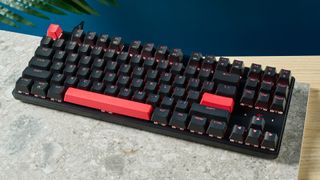
Specifications
Reasons to buy
Reasons to avoid
The Lemokey X1 is a no-brainer if you’re on a budget but crave quality. Priced at just $36, it delivers an awesome performance for both typing and gaming, boasting features typically found in more expensive models. Its body feels premium and robust, and the tactile brown switches we tested offer a delightful typing experience. The keyboard's 1,000Hz polling rate ensures excellent gaming responsiveness, outperforming other budget options like the MageGee Sky87.
The X1 also has red-only backlighting which can be customized via Lemokey Launcher, its intuitive companion software, which can also be used to remap keys, program macros, and more. The keyboard isn’t without its flaws though, as the ABS keycaps feel less than premium and may suffer wear and tear over time. Additionally, it lacks hot-swappable switches which could deter modders. Despite these minor drawbacks, the X1 remains an outstanding choice for anyone seeking a budget-friendly mechanical keyboard with premium features.
Read our full Lemokey X1 review.
The best wired mechanical keyboard
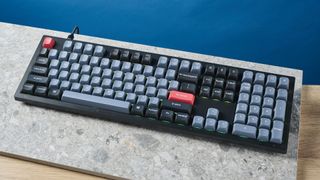
Specifications
Reasons to buy
Reasons to avoid
If you’re after a wired, full-size mechanical keyboard, the Keychron V6 should be your first port of call. It’s built like a tank, using layers of internal insulation that keep the board rigid, as well as dampening the sound for a deep, linear thump.
As standard, it comes with lovely doubleshot PBT keycaps that feel wonderful to type on and will stand the test of time (especially versus ABS keycaps). It has customizable RGB lighting, can be purchased with either red, blue or brown switches, and is fully hot-swappable and easy to disassemble, making it a great platform for modding. You can also buy the V6 in a “bare bones” format, without keycaps or switches — the ideal base for a custom build.
This is a wired board, so if you want a battery-powered keyboard with wireless connectivity, it won’t be for you. As a full-size, well-insulated keyboard, it’s also quite heavy, but the V6 is designed to sit at a desk instead of being taken to work. If you find the standard keycaps a little mundane, Keychron offers a range of different keycap sets in spicier colors to customize the board as you like — with all the money you save over rivals, buying extras won’t be a problem.
Read our full Keychron V6 wired review.
The best wireless mechanical keyboard
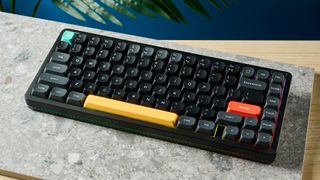
Specifications
Reasons to buy
Reasons to avoid
The NuPhy Halo75 V2 is a 75% custom-style keyboard that looks and sounds gorgeous, and types like a dream. It features six layers of internal padding and dampening, giving the keyboard a resonant sound. This is perfectly complemented by heavy doubleshot PBT keycaps and lovely sounding NuPhy x Gateron switches (Lemon tactile, Raspberry linear or Mint linear), which give the board an elegant thocky sound.
Most impressive though are those keycaps, which NuPhy has redesigned from the original Halo75 to create its mSA profile. These are super comfortable to use and sit somewhere between low- and high-profile keycaps. This results in the typing benefits of low-profile caps, with the styling, sound and feel of high-profile ones. This keyboard is an absolute joy to type on.
Its eponymous halo lighting system looks the part too, casting a soft glowing halo on your desk, and battery life is pretty good given the amount of lighting on the board. It should last you two to three weeks on a single charge.
Read our full NuPhy Halo75 V2 review.
The best gaming mechanical keyboard
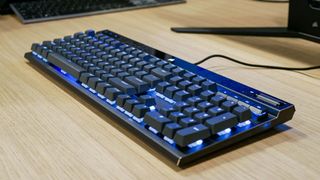
Specifications
Reasons to buy
Reasons to avoid
The Corsair K70 Max is one of the most impressive gaming keyboards out there. The big selling point is its linear magnetic switches, which let you adjust the key's actuation point. Since the keys are magnetic, you're also able to program two functions on the same key. On top of that, it also has sound-dampening technology for quieter keystrokes, a tough aluminum frame and even a comfortable memory foam wrist rest. Overall, it's one of the best mechanical keyboards out there.
The comfortable wrist rest and insane level of customization are also strong bonuses. $230 isn't cheap, but if you're in the market for a gaming keyboard with more features than you might need, the Corsair K70 Max is worth checking out.
Read our full Corsair K70 Max review.
The best hot swappable keyboard
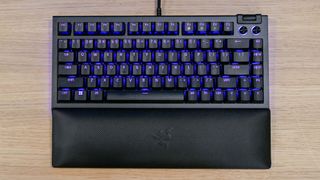
Specifications
Reasons to buy
Reasons to avoid
The Razer BlackWidow V4 75% is arguably the best mechanical keyboard Razer has ever released. Featuring the latest version of the company’s Orange Tactile mechanical switches, a compact 75% layout, and features borrowed directly from the keyboard modding community, the BlackWidow V4 75% is one of the best gaming keyboards you can buy.
This is the company's first hot-swappable keyboard, which is a huge bonus if you're into modding your mechanical keyboard. However, we’d argue you don’t need to mod it at all since it’s so great out of the box.
Read our full Razer BlackWidow V4 75% review.
The best TKL mechanical keyboard

Specifications
Reasons to buy
Reasons to avoid
The Logitech G915 TKL is exactly what it sounds like — a tenkeyless version of the similarly excellent Logitech G915. Like the full-size model, the G915 TKL is a stylish and expensive peripheral. It's also one of the only good wireless mechanical gaming keyboards on the market. If you want to ditch your wired setup but don't have a lot of desk space available, this is probably the model for you.
As with other Logitech models, the G915 TKL benefits from excellent key switches, intuitive software and a durable design. You still get discrete media keys, as well as thin, elevated keycaps and per-key RGB illumination. While the G915 TKL costs almost twice as much as similar wired models, it's arguably worth the premium, especially if you find yourself moving the keyboard around to take advantage of its USB dongle and Bluetooth connection profiles.
Read our full Logitech G915 TKL review.
The best mini mechanical keyboard

Specifications
Reasons to buy
Reasons to avoid
What the SteelSeries Apex Pro Mini lacks in number of keys, it makes up for with its brilliantly responsive Hall Effect switches. This 60% gaming keyboard offers a plethora of great features thanks to its OmniPoint switches, such as useful dual actuation points and adjustable distance, on top of a fantastic build quality and sleek appearance. The Apex Pro Mini offers a more affordable pathway into Hall Effect switches, while saving on desk space compared to the full-sized Apex Pro.
You will need to look past some issues— there are minor brightness issues with the RGB lighting and the Hall Effect switches are not ideal for long-form typing. The Apex Pro Mini does not offer the smoothest experience for productivity, but makes an effort to account for this with handy shortcuts to the most used keys. Offering powerful per-key customisation in a small package, the Apex Pro Mini is an excellent mini keyboard for gaming.
Read our full SteelSeries Apex Pro review.
The best ergonomic mechanical keyboard
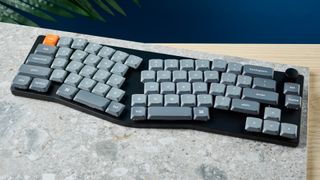
Specifications
Reasons to buy
Reasons to avoid
The Keychron K11 Max is an excellent wireless keyboard for all your ergonomic needs. It’s got a 65% Alice layout which means it’s split and slightly tilted to relieve strain on your wrists. If you aren’t used to a keyboard like this, getting to grips with it might feel like an uphill walk, but it’s worth it. The K11 Max offers a great typing experience and its low profile keycaps and switches are very comfortable to type on. It’s built really well too, with an aluminum frame plus double-shot oil-resistant PBT keycaps which won’t fade over time.
But the K11 Max’s companion software feels finicky as you can’t use it to change the hue and brightness of the RGB lighting, nor can you remap the metallic knob. Furthermore, while its body is built well, the feet are slightly loose making the board easy to knock and move. There’s also no onboard dongle storage, so keep a close eye on that small 2.4GHz adapter.
If you’re willing to overlook these flaws, the K11 Max is a great keyboard that excels at providing its users with a comfortable typing experience.
Read our full Keychron K11 Max review.
How to choose the best mechanical keyboard
Design: What size keyboard do you want? Most of us are used to a full-sized keyboard, which has the separate number pad on the right-hand side. But if you don't care about that number pad and/or want something a bit smaller, consider getting a tenkeyless keyboard, which doesn't have the separate number pad. There are a variety of sizes to choose from based on your needs, usually denoted as percentages of a full keyboard (so a 60% mini keyboard is 60% the size of a full keyboard and typically only includes the main typing keys and the number row, for example).
Switches: What kind of switches do you want on your keyboard? There are lots of options to choose from, but they generally vary in two big ways: how noisy they are, and when they register a keypress. Switches that register a keypress (or actuate) when you press them all the way in are called linear switches, whereas those that actuate when you press them roughly halfway down are called tactile switches. Once you know whether you want quiet vs noisy and linear vs tactile, you'll have narrowed your options down from dozens to a handful.
Our guide to mechanical switches will give you more details on some of the top switches on the market, but if you're not sure, it's a safe bet to get Cherry MX switches on your keyboard as they're some of the best in the business.
Price: A good mechanical keyboard will likely cost you between $100 to $200, depending on which one you want and when you buy it. (Hint: Black Friday and Cyber Monday are great days to find good deals on keyboards.) While that might seem high for a keyboard, remember that you're paying for quality: A $20 to $30 membrane keyboard from Microsoft or Dell will work well enough, but it won't be nearly as comfortable (or last as long) as a high-quality mechanical keyboard. Still, if you're looking for something a little cheaper, you can get a quality mechanical keyboard like the Razer BlackWidow Lite for roughly $70.
How we test mechanical keyboards
To determine the best mechanical keyboard, we run each keyboard we review through a variety of tests. The first, and most important, test is to play through a number of different games, and see how the keyboard holds up. I usually like to try at least one FPS, RTS, RPG and MMO apiece, since these are the genres that benefit most from a good keyboard. (You can generally get away with a controller for most action/adventure titles.)
After that, we take a deep dive into a keyboard's software suite, evaluating how easy (or difficult) it is to reprogram keys, set up macros, adjust lighting and create profiles for games. Particularly intuitive software gets high marks; convoluted software can lose some points, even if it's very robust otherwise.
Finally, we make sure to use a keyboard for productivity and personal gaming for at least two or three days. Most of us don't swap keyboards in and out; what you use for gaming, you'll need to use for work and general computing as well. The better a keyboard is at everyday tasks, the better its recommendation.
For more information, check out our how we test page for Tom's Guide.
Next: How to clean a mechanical keyboard.
Also tested
Epomaker TH80 Pro: was $99 now $89 @ Amazon
The retro-looking Epomaker TH80 Pro is hot-swappable for maximum customization, comes with a handy app to personalize the keyboard to your liking, and has been a great typing experience. But you might want to invest in a wrist rest if you type for hours and keep the manual on hand to remind yourself of secondary functions.
Keychron Q3 Max: $234 @ Amazon
A gorgeous keyboard, either in the retro or stealth fighter styles available. Encased entirely in metal and acoustically damped to oblivion, the Q3 Max sounds epic and won’t give you any headaches in the build quality department. 1,000Hz polling also makes it a suitable gaming board if you so desire. Unfortunately, it’s expensive, heavy, and the lack of height adjustability might have you considering other options.
Lofree Block: $169 @ Amazon
With its ‘70s sci-fi styling, the Lofree Block looks like it’s come straight from the Nostromo in “Alien”. Offering charming retro looks and sound, plus a comfortable typing experience for long stints of productivity. It isn’t perfect, with subpar battery life and no software for customization, and you can get better value for money elsewhere, but overall this is an incredibly easy board to recommend.
Razer BlackWidow Lite TKL: was $89 now $49 @ Amazon
The Razer BlackWidow Lite ($90) is a tenkeyless mechanical keyboard that aims to split the difference between a gaming accessory and a productivity peripheral. While it bears the hallmark Razer design and functionality, it's eschewed just about anything that would make a gaming keyboard look out of place in an office environment, like RGB lighting or extra rows of macro keys.
Gamakay LK75: $109 @ Amazon
The Gamakay LK75 feels like a dream for a typist and gamer like me. It’s beautifully designed with a space theme, and it’s built well. It’s also hot-swappable, comes with a smart knob that can display any image or GIF you like, and its in-depth companion software lets you truly make this keyboard your own. There are a couple of minor flaws, though, which are quickly remedied by everything else it does right.
Epomaker DynaTab75: $99 @ Amazon
The Epomaker DynaTab75 boasts gorgeous looks and excellent construction. Better yet, it has a slot for your tablet! Typing on this keyboard is delightful, as is playing FPS and RPGs as the keys provide great tactile feedback and register presses accurately. Its user-friendly software makes it easy to customize the keyboard, making this hot-swappable board great value for money.
Sign up to get the BEST of Tom's Guide direct to your inbox.
Here at Tom’s Guide our expert editors are committed to bringing you the best news, reviews and guides to help you stay informed and ahead of the curve!

Tony is a computing writer at Tom’s Guide covering laptops, tablets, Windows, and iOS. During his off-hours, Tony enjoys reading comic books, playing video games, reading speculative fiction novels, and spending too much time on X/Twitter. His non-nerdy pursuits involve attending Hard Rock/Heavy Metal concerts and going to NYC bars with friends and colleagues. His work has appeared in publications such as Laptop Mag, PC Mag, and various independent gaming sites.
- Alex WawroSenior Editor Computing

